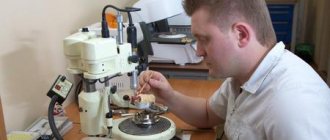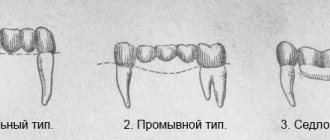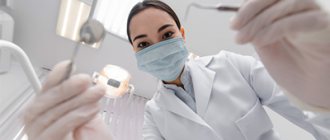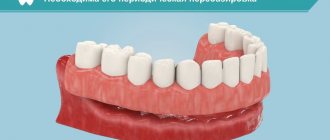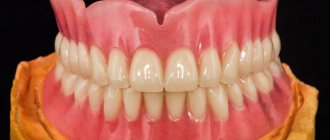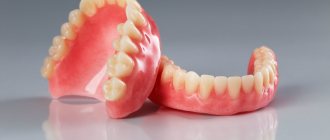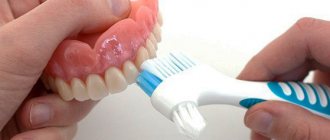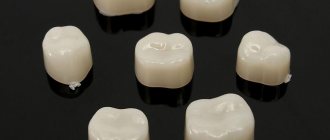The stages of making a clasp denture is a procedure that involves a professional and careful approach in dentistry. As a result of the step-by-step process, a product is obtained that successfully replaces implants and restores the dentition. The design is indicated for certain disorders and in the absence of natural units in the dentition. It is installed during the period of preparation for prosthetics to maintain aesthetics, correct deep bites, as well as for the treatment of periodontal disease and bruxism. Clasps have a number of advantages and, with proper care, last a long time. Modern orthopedic dentistry offers several types of clasps, for the manufacture of which special materials are used.
What are clasp dentures and what do they look like?
These are removable structures used to restore included and terminal defects of the dentition. They are lighter and more comfortable than plate prostheses with a “sky”, and are in demand in cases where prosthetics on implants cannot be performed.
With the help of a clasp prosthesis, chewing function and aesthetics are restored both in the anterior and lateral sections of the jaw. In the smile zone, they most often use prosthetics from one to three consecutive teeth, and in the lateral sections - longer areas (3-5 missing teeth on one or both sides).
Externally, it is a simple design consisting of a metal arch and plastic imitation of gums with artificial teeth. The absence of a “sky”, characteristic of plate dentures, makes the clasp a lighter and more compact option. You get used to it faster and feel less discomfort. It does not interfere with conversation and is hardly noticeable in the mouth.
General overview
Clasp denture is one of the types of removable orthodontic structures. This is a very light, elegant, reliable and comfortable device to wear that does not distort diction.
All models of clasps are technically complex. They are based on a durable metal frame, a saddle-shaped acrylic base, artificial units and fastening devices.
All parts of the device are connected to each other by an arc. It also performs a fixing function. The frame itself can be made in two versions - solid cast or soldered. The second one is much easier to produce, cheaper, but not so convenient to use.
An important condition for the installation of these products is the presence in the mouth of several fairly stable and strong teeth. It is these units that will hold the removable structure.
The degree of sensitivity of the tissues and mucous membranes of the gums, the condition of the periodontium, and the size and shape of the alveoli are also of great importance.
What does a clasp prosthesis consist of, what materials are used in its manufacture?
A modern clasp prosthesis, made from high-quality materials, looks quite aesthetically pleasing. It consists of four parts.
- Frame (clasp). Durable, thin and light. It includes: a cast arch that evenly transfers the load to the jaw in places of missing teeth, slowing down the processes of bone resorption;
- mesh for attaching artificial teeth, allowing you to create a single structure;
- fasteners (clasps, beam structures, telescopic crowns, anchor and magnetic clamps) for rigid, elastic or hinged fastening on supports (healthy teeth, implants, crowns);
- splinting elements (according to indications - claw-shaped hooks, clasps, Elbrecht splints).
Materials for making a prosthesis
- Frame, fasteners. Using classical technology, the base of the structure is made of metal using modern casting methods. Depending on individual tolerance and other criteria, alloys of noble metals, cobalt-nickel-chrome with minor impurities, as well as titanium are used.
Currently, there are more modern materials - thermoplastic polymers, which are not inferior in strength to metal, but are more elastic and comfortable. The most famous are ACETAL or Dental D from QuattroTi.
- Base. It is made using classical technology - hot polymerization from acrylic, and in modern versions, like the frame, from thermopolymers.
- Teeth. Plastic, composites.
The choice in favor of one or another material is determined by the individual sensitivity, wishes and financial capabilities of the patient.
Material used
All structural elements of the system are made using different materials. So, for the manufacture of the frame and arc, a cobalt-nickel alloy or stainless steel .
The alloy product is hypoallergenic and has a high biocompatibility with periodontal tissues.
Less popular is the system, the parts of which are made of steel. Its disadvantage is that an oxide film forms very quickly at the soldering points (its appearance indicates the beginning of the oxidation process).
The base on which the artificial chewing elements are placed is usually made of acrylic (a type of plastic). Despite the lightness of the material, it is quite durable.
All small elements (including fasteners) are made of titanium, which reduces the overall weight and parameters of the product. It is this fact that reduces the adaptation period to the system to 3-5 days.
For artificial chewing elements, metal-ceramics or ceramics (plastics are used less frequently).
Where does the process of making removable dentures begin, and what material is used?
Find out about the effectiveness of denture retaining spacers here.
At this address https://zubovv.ru/protezirovanie/semnyie-p/komu-podoydut-akri-fri.html you will find a selection of positive and negative reviews about Akri Fri removable dentures.
Pros and cons of clasp prosthetics
This type of replacement structure is the pinnacle of removable prosthetics. On the one hand, it can be used to restore a large number of lost teeth. On the other hand, even in difficult cases (for example, two teeth are missing in front, three on the right, and five on the left), this is still a light and comfortable prosthetic system.
The following are responsible for comfort during clasp prosthetics:
- a very thin arch that presses tightly against the palate when worn;
- reliable fasteners providing rigid fixation.
Thanks to this, the prosthesis does not play during conversation, chewing and is practically not felt by the patient. This is a truly reliable type of prosthetics.
The main advantages of clasp dentures
- Functionality. A rigid type of fixation with support not only on the gums, but also on the teeth, completely restores chewing function.
- Strength. The presence of a metal frame makes it possible to install prosthetic teeth even with severe violations of the integrity of the dentition.
- Hygiene. Depending on the type of fixation, clasp dentures are removable and conditionally removable. Some are easy to clean at home, while others can be cleaned during hygienic cleaning at the dental clinic.
- Durability. Durable modern materials and uniform load distribution make the prosthesis reliable, allowing it to be used for 5–10 years.
- Aesthetics. Correct selection of the shade of the polymer base and dental crowns makes the artificial part indistinguishable from the patient’s own teeth. Options with attachments, telescopic crowns and thermopolymers are invisible in the smile area.
- Bioinertness. Thanks to titanium, as well as modern thermoplastics, replacing lost teeth does not harm the body. The materials are hypoallergenic and do not interact physically or chemically with the oral environment. This means that the taste sensations are completely preserved.
- Convenience. The minimal size of the prosthesis (thin arch and only one layer of polymer) allows you to not feel it when wearing it, does not affect diction, does not cause discomfort or a gag reflex, so the prosthesis can be worn around the clock.
- Splinting. This type of prosthetics can be used even with loose gums and loose supporting teeth. Adding special splints to the frame will help keep the supporting teeth in the desired position, prolonging their life.
- Maintainability. In most cases, a prosthesis can be repaired if it breaks. Only some types of fasteners cannot be restored.
The production technology has been worked out to the smallest detail, and is optimal in terms of price and time. This is also an important advantage.
Disadvantages of clasp dentures
- High price. If we compare the clasp with a conventional plate prosthesis, the difference in price attracts attention. It is formed taking into account complex manufacturing technology and the use of expensive materials. This cannot be considered a real disadvantage, because better quality means additional comfort and aesthetics, as well as 2-3 times longer service life.
- Grinding teeth for crowns. In some cases, it may be necessary to prepare healthy tissue and remove the dental nerve to form a support.
- Not used for edentulous patients. In case of complete absence of teeth, our dentist will offer more cost-effective prosthetics using All-on-4 implants.
Cheaper options have additional disadvantages, including the effect of galvanization and allergies to metal, discomfort for 1–2 weeks during the adaptation period, less aesthetics of fasteners, as well as bone resorption, which can only be avoided by prosthetics on implants.
Price
The cost of clasp structures is high in comparison with other removable products. But, despite this fact, their use today is one of the most popular services in dental clinics.
This table provides information on the average cost of various clasp systems. These figures already include payment for oral cavity preparation services.
| Type of prosthesis | Price, thousand rubles |
| Simple for one jaw | from 15 |
| System for 2 jaws | about 25 |
| Splint system | from 20 |
| Micro-lock design | about 40 |
| Product on telescopes | about 70 |
The figures given are subject to change. Their upward fluctuation depends on the complexity of the design itself, the type of material used in production, and the type of fastening used.
Indications and contraindications for installation
The choice in favor of clasp dentures is made in the presence of dentition defects, both single (1-3 teeth - Quadrotti’s “butterfly”), and multiple – included and terminal bilateral.
Contraindications:
- metal allergy;
- complete absence of teeth;
- atrophic processes in the jaw;
- inflammatory diseases of the gums and periodontium;
- low height of supporting teeth, insufficient for prosthetics.
Many contraindications apply to classic metal prostheses. The use of technologically more advanced thermoplastic options expands the range of indications for installation.
Purpose of structures
A clasp denture is one of many structures designed to reconstruct the integrity of the dentition in the absence of natural units on it.
Its installation is possible for the following indications:
- the presence of end bilateral and unilateral defects of the row;
- inability to place a non-removable device;
- loose teeth associated with periodontal diseases;
- the presence of single or included defects;
- replacement of anterior units;
- pathological abrasion of teeth.
The clasp is very often installed during preparation for prosthetics to preserve the overall aesthetics of the face. It can be used to correct deep bites, treat periodontal disease and bruxism.
Manufacturing and installation process, stages of work
Preparation
The creation of a clasp prosthesis begins with the planning stage. The patient's oral cavity undergoes a thorough examination. Orthopantomography and CT scanning of the jaw will help to examine all its anatomical features and ongoing processes.
It is important to know:
- Causes of tooth loss. This will help protect the supporting crowns from caries, as well as periodontal and periodontal diseases.
- The degree of their mobility. If necessary, the frame is supplemented with hooks, tires and other fasteners.
- Presence of jaw atrophy. In advanced cases, clasp prosthetics is not recommended. Only implantation can help.
If any diseases are revealed during the examination, sanitation of the oral cavity is required before prosthetics. Professional hygienic cleaning is also recommended, which will reveal the natural color of the patient’s tooth enamel in order to correctly select acrylic, thermopolymers or composite materials.
Impressions
To work, it is necessary to obtain two-layer anatomical impressions, with the help of which working models are made and the degree of fit, load distribution, compression level and other important parameters of the functionality of the prosthesis are subsequently controlled. The impression is taken using an individual tray.
Working model
Using super plaster, two working models are created based on the impression. One of them is used in the process of planning and modeling the frame, as well as installing dental crowns - up to the complete production of a partial denture. And the second is needed to check the cast metal frame.
Subsequently, using the plaster model as a basis, an identical one is made in a dental laboratory, but from refractory ceramics. With its help, wax modeling of the frame is carried out, taking into account all clasps, branches, retention meshes, fastening processes, occlusal pads and other elements, and subsequent metal casting is also performed.
Frame formation
Making a refractory ceramic model on top of the primary one with a wax model of the frame allows you to create space for pouring metal in exact accordance with the frame drawings. Subsequently, in an induction furnace or using other technology and equipment, the metal is heated to the required temperature and poured into the mold.
After cooling, the surface is processed to remove mold residues and polished until an ideal fit to the working model is achieved, and then in the oral cavity during fitting.
Basic requirements for this:
- compliance with original drawings;
- absence of defects (sagging, cavities);
- ideal fit on the support and prosthetic bed;
- no problems when closing the dentition.
Formation of the base and installation of dental crowns
Artificial teeth are installed on a finished metal frame using a wax roller, and then the base of the clasp denture is modeled, taking into account the characteristics of the patient’s gums (size of interdental papillae, periodontal ridges).
Then, after checking the correctness of the created design by trying it on with the patient, the prosthesis is plastered and the wax is replaced with acrylic. The finished result must be aesthetic and correspond to the drawing conceived at the very beginning.
Checking the prosthesis for fit and installation
The finished prosthesis is tried on a model, and then the fit in the oral cavity is assessed. The result is considered ideal if the prosthesis is as similar as possible to the tissue in the patient’s oral cavity. It must be perfectly polished, match the color scheme of natural tooth enamel and periodontal tissues, fit accurately onto the support and prosthetic bed, and ensure ideal occlusion. After the final fitting, the finished product is polished and then secured in the patient’s mouth.
Consultation
The dentist at our clinic will definitely instruct the patient on how to care for the clasp denture in order to maximize its service life. Will answer any question and remind you of the need for professional hygienic cleaning of dentures. This will save artificial teeth for many years.
Varieties
There are several types of clasp structures. Each of them has its own advantages and disadvantages.
Distinctive features lie in the technological regulations for creating products, fixation methods, and types of base material. Let's look at the types in detail:
Castle
The system is equipped with unique locks , which include two parts. The first is fixed on the product itself, the second is mounted on a metal-ceramic crown.
Such fastening elements close automatically. The specialist has the opportunity to choose the appropriate type of locks from deadbolt, rail, and spherical models.
With this fastening, the load on the specimens and gum tissue is distributed evenly. The presented model has an aesthetic appearance, therefore it is practically invisible to others during close communication.
The main advantages are compactness and reliable fixation. One of the disadvantages is the need to prepare supporting units.
Clasp
Popular and affordable design. It is made by casting and equipped with a metal frame. Such a product tightly covers the supporting units and is firmly fixed without moving.
All parts of the structure work to properly distribute loads during eating.
The impact on healthy fragments of the jaw row is minimal. The main load is distributed over the gingival structures. Preliminary grinding of the tooth for fixation is not required.
Telescopic
The clasp on a retractable crown is considered the most comfortable and aesthetically pleasing. However, the process of such prosthetics itself is complex and requires a specialist to have certain skills in the work.
The telescopic crown device has unique upper and lower parts. The non-removable component is presented in the form of a crown and is fixed on the prepared supporting organs of the jaw row.
The removable part is attached to the structure, and during installation in the oral cavity it is placed on supporting specimens. Thanks to the interaction of both parts, fastening is carried out reliably.
Splinting
Patients often suffer from many dental pathologies. There is a need to strengthen units, level them, or get rid of severe instability. In such cases, experts recommend prosthetics with a splinting structure.
The device fixes the units in a constant position and is secured on the inside using a special metal plate that exactly repeats the shape of the units.
The design does not harm the enamel during use and maintains the healthy structure of the jaw rows.
Indications for installation of a dental microprosthesis, advantages and disadvantages of the design.
Evaluate here the result of restoring the dentition with a splinting clasp prosthesis based on the patient’s photo.
At this address https://www.vash-dentist.ru/protezirovanie/semnyie-p/primenenie-uslovno.html we offer a detailed description of a conditionally removable denture.
How clasp dentures are attached, their types, methods of fixation
Artificial structures are fixed using four main methods:
- adhesion. This is the name for the process of adhesion of two surfaces. In a clasp, it is acrylic or thermoplastic on one side, and the mucous membrane of the prosthetic bed on the other. This effect is enhanced by the presence of oral fluid;
- adhesion. One of the types of adhesion, when there is stronger adhesion between the molecules of the liquid and the surface during prosthetics than the intermolecular adhesion force of the oral fluid;
- anatomical retention. A number of structural features of the jaws make it possible to fix and hold the prosthetic structure in the oral cavity. These are the alveolar parts, maxillary cusps, interdental spaces, perigingival zone of the crowns;
- artificial fixation. It is carried out using manually created fastening elements. Among them, the following retainers are distinguished: Straight, located on the supporting teeth. Their task is to prevent the prosthesis from moving vertically.
- Indirect, located on the periphery of the structure. Also called kipmaiders. Prevents the structure from falling off. These include continuous clasps, occlusal overlays, and special extensions.
Let's consider all the options for artificial fixation in more detail.
On clasps
These are support-retaining clamps that have been used in prosthetics since 1926. Since their introduction, they have significantly expanded the possibilities of replacing lost teeth.
The structure of clasps is very diverse. They usually consist of two pointed arms and an occlusal pad, but different variations are possible depending on the purpose and purpose of fixation (two pads and an extended arm, multi-link splinting options, etc.).
Classification of clamps is carried out according to:
- principle of creation (bent, cast);
- material (plastic, metal);
- cross-sectional shape (round, ribbon, semicircular);
- rigidity of fixation (rigid, elastic, hinged);
- functionality (retaining, supporting, combined);
- degree of coverage of the dental crown (2-arms, 1-arms, flip-flop, double, multi-link);
- location of the shoulder (dental, alveolar, combined).
There are several requirements for clasps. They should not:
- harm aesthetics;
- injure periodontal tissues;
- interfere with the closure of the dentition;
- influence the physicochemical constancy of the environment.
They must also be able to be reactivated.
On locks (attachments)
Commonly used mechanical fasteners. Used for stabilization and retention. They consist of two parts - patrix and matrix. Functions – transmit the load through the axes of the teeth-supports into the periodontal tissue, participate in the redistribution of chewing pressure.
Pros - they fix and stabilize better than clasps. Higher hygiene and aesthetics, mechanical reliability and convenience. They allow you to create bridges of high quality and aesthetics when prosthetizing included defects in the smile area.
They are actively used in cases where increased demands are placed on dentures in terms of aesthetics, if there are secondary deformations of the dentition, atypical position and high crowns of supporting teeth.
On telescopic crowns
A fixation system consisting of two crowns - external (tooth-shaped) and internal (looks like a cap that is placed on prepared supporting tissues). Based on the manufacturing method, telescopic crowns are divided into stamped (simpler) and cast (high-quality), and based on the overlapping supports - closed, open and combined.
Plus - more reliable redistribution of load along the axis of the supports during operation. The downside is the need for significant preparation of the supporting teeth.
Beam system
The prosthesis is secured with this type of fixation by connecting its fixed and removable parts. The first is placed on the tops of crowns or prepared tissues of supporting teeth and has the form of a beam with a rounded cross-section. The second, removable, is located inside the prosthetic frame and is tightly fixed to the beam.
Pros – actively used for periodontal diseases. Recommended in the presence of partial edentia, single supporting symmetrical teeth, as well as a long-term defect in the lateral part of the jaw.
On anchors
This is a special type of fixation that works on the principle of a clothing button. The anchor consists of two fastening elements – a male and a matrix. Most often, the first is placed on the supporting tooth, and the second on the structure.
Pros: miniature size. Due to this, the anchors can be placed in areas of the base inaccessible to other clamps. Disadvantages - rapid wear during use (when removing/putting on).
Creation time
The creation of clasp systems takes more time than the production of other removable structures:
- the device with clasps takes about 10-12 days;
- analog product with attachments – at least 20 days;
- the system on telescopic crowns will be ready in 3-4 weeks.
But these are only approximate times for the technician to complete the work. Depending on how busy it is, production may take longer, or vice versa, it may be halved.
Useful recommendations on where to place a covering prosthesis, and what to look for when choosing a specialist.
This material is devoted to the design of the Sandwich denture.
Here https://zubovv.ru/protezirovanie/semnyie-p/byugelnyie/na-nizhnyuyu-chelyust.html about the features of making a clasp denture for the lower jaw.
Special clasp-type prosthetic structures
Clasp prosthesis Quadrotti
Produced using the unique patented Quattro Ti technology since 1986. The prosthesis is based on a thermopolymer (nylon-based plastic). There is no metal. Thanks to this, the prosthesis has many advantages:
- hypoallergenic;
- highest aesthetics;
- chemical inertness;
- short adaptation period;
- complete biocompatibility;
- no gum irritation;
- installation without tooth preparation.
Attention. Due to the flexibility of the design, its significant advantage is that it can be used by those who engage in boxing, wrestling and other traumatic sports, as well as those who work in harmful and dangerous industries.
Comfort of wearing is ensured by high adhesion to the surface of the prosthetic bed, elastic material, and soft clasps. Due to the lack of possibility of relining, such prostheses must be changed once every 3–3.5 years.
Quattro Ti manufacturing features
The Quadrotti prosthesis is made in a dental laboratory individually for each patient using the thermocasting method. For these purposes, special equipment and raw materials are used, from which the future prosthesis is formed based on the impression and model of the jaw.
The manufacturing technology is worked out to the smallest detail, so butterfly prostheses and larger thermoplastic structures wear well. Their invisibility on the teeth is ensured by the presence of several shades of raw materials.
White plastic is used inside and for hooks (clasps), and red plastic is used to make the gingival part. It practically blends with the color of the oral mucosa, so the structure on the teeth is not only not felt, but also invisible.
Care for Quattro Ti prostheses should be more gentle. They need to be cleaned with a soft brush and a special paste designed for elastic plastics. Periodic disinfection with a special disinfectant solution is recommended. For details, please contact your dentist at our clinic.
Splinting clasp dentures
In case of increased instability of the supporting teeth and the presence of a defect in the dentition, it is recommended to install dentures, the design of which contains special elements (processes, clasps). With their help, the prosthesis tightly covers the crowns of the teeth, which avoids further loosening.
The indication for wearing a splinting prosthesis is not only degree II-III tooth mobility, but also a pathological deep bite along with increased abrasion of the tooth surface.
Its distinctive feature is the presence of individual hooks on the teeth or an entire arch running along the inner surface of the dentition.
The advantage of this design is the uniform distribution of the load throughout the jaw, rather than concentrating it on just the supporting teeth. It is also worth additionally noting such an important plus as light weight.
Technologies
The design of the clasps is complex, so they are made only in dental laboratories equipped with special equipment. Two technologies are used for this:
- Casting with removal of the model from the blank. The method involves taking a wax impression from a plaster model and then placing it in a refractory compound. The wax is removed and replaced with liquid metal.
- Casting a refractory sample, during which the base is modeled.
This method has two advantages over previous technology. Firstly, the metal does not “shrink”, and secondly, the possibility of changing the parameters of the wax blank during its removal from the model and packaging into a refractory mass is excluded.
Important! Cast structures are very thin, reliable, lightweight and very accurate, so the period of getting used to them is very short.
Prosthetics for complete absence of teeth and for one tooth
In case of complete absence of teeth, clasp dentures are installed in one case - when supported by implants. This is a more advanced prosthetics principle from a functional point of view. It allows you to avoid resorption of the jaw bone tissue, evenly distributing the load on the bone.
Clasp prosthetics for one tooth before the advent of thermopolymer products were considered illogical, since they required grinding down adjacent and often completely healthy crowns. Metal-based dentures made it possible to replace a lost tooth only as part of complex structures - with lateral end defects and included defects of the anterior teeth.
Thanks to Quadrotti technology, there is currently no need to prepare adjacent healthy teeth for a prosthesis. And a single included defect in the dentition is successfully replaced with an elastic thermopolymer “butterfly”.
Advantages and disadvantages
Any design used in prosthetics has its advantages and disadvantages. Clasp designs are no exception. The advantages are as follows:
- light weight and compact design;
- reliable fastening in the oral cavity;
- uniform distribution of loads during chewing;
- absence of disturbances in diction and taste perception when fixing on the upper jaw;
- ease of daily care;
- long period of operation.
Minuses:
- allergic manifestations to metal elements are possible;
- long period of adaptation;
- mandatory presence of several healthy teeth for installation;
- Over time, there is a risk of dental tissue atrophy;
- high cost compared to plate and bridge structures.
From the video, learn about the pros and cons of devices with different types of fixation.
Denture for front teeth
Prosthetic treatment of dental defects in the smile area requires special attention. A prosthesis requires a high level of aesthetics and functionality.
Of course, the ideal option for such a lack of teeth would be implantation. However, if for objective reasons it cannot be carried out, then the choice often falls on clasp dentures.
Prostheses based on attachments and telescopic crowns have proven themselves well when installed on the front teeth. They are light, almost invisible, and attach well to the supporting teeth. If desired, you can also choose a Quadrotti prosthesis, the advantages of which we have already mentioned.
Reviews
The presented type of prosthetics, although considered partly democratic, still remains inaccessible to most patients.
However, this is the best offer that dentistry can recommend today for the stated price. Prosthetics with clasp products are reliable, safe and durable.
You can leave your feedback on the prosthetic technique in the comments to this article.
If you find an error, please select a piece of text and press Ctrl+Enter.
Tags clasp dentures removable dentures
Did you like the article? stay tuned
Previous article
What is unique about Korean Anyridge implants?
Next article
What to do if a splinter remains after tooth extraction
Service life and how to care
On average, the service life of a clasp prosthesis is 2–3 times longer than that of a conventional plate prosthesis. This is achieved through more advanced production technology and high-quality raw materials.
With good care - daily at home and regular professional hygienic cleaning in dentistry - your new teeth will last from 5 to 7 years. On implants – up to 10 years due to the absence of resorption, play and displacement during chewing.
Caring for clasp dentures
Every day, twice a day at least, and ideally after every meal, you need to brush your teeth. If the denture is removable, remove it and wash it with soap or toothpaste, thoroughly cleaning the surfaces with a brush. Rinse with boiled or purified water.
Once a day, disinfection should be carried out by dipping the prosthesis in a disinfectant solution for 5–10 minutes. For its preparation, special water-soluble tablets are used. Once a week you can soak it for a longer period in a bio-solution for better cleaning.
Using this method, all biological debris, including pieces of food and plaque, are removed from the prosthetic surface. After disinfection, the product is washed with boiled water and is ready for storage in a case or use. Dentists strongly do not recommend leaving the prosthesis in storage for a long time, especially if it has a splinting effect.
You should make an appointment for professional cleaning at least twice a year. In this case, the denture workshop cleans the polymer and metal parts, as well as calibrates them to fit the patient’s jaw.
Careful care, timely repairs and relining extend the life of the product, allowing you to avoid its breakage due to the gingival contour changing over time and the associated improper load distribution.
Obtaining a design on a fire-resistant model
The laboratory stages of making a clasp prosthesis include an important point - taking impressions. The initial plaster model is of great importance for obtaining the casting of the prosthesis frame (so that everything is accurate down to the millimeter).
If the prosthesis is prepared on a fire-resistant model, then two casts of workers and one additional one are made. When making dentures for two jaws at once, four are obtained, that is, two from each jaw. This is done so that one model can be used for examination and subsequent copying, and the second is used for making a base with rollers, for determining occlusion, plastering and final production of the prosthesis.
The working model is of great importance for obtaining a high-quality prosthesis, so a specialist must constantly keep under control the clinical and laboratory stages of manufacturing clasp prostheses.
Models of jaws must be as strong as possible so that they are not subject to abrasion, therefore parts that are especially susceptible to pressure and load are made of supergypsum, metal, cement or amalgam.
If during the work a defect in the working model is revealed, the cast will have to be redone.
Price
The price of clasp prosthetics depends on the degree of complexity of the clinical case - the number of defects, their location, selected materials and manufacturing technology. Prices for prosthetics start from 50 thousand rubles.
The final cost of treatment is also influenced by the preparation and depulpation of supporting teeth for a crown, concomitant treatment of caries, gum and periodontal diseases, and bleaching for the optimal choice of shade of polymers.
You can find out how much a clasp prosthesis will cost in your particular case and ask any questions you have by consulting with an orthopedist in our clinic. Call to make an appointment at a time convenient for you. We'll be happy to help!
Clasp acetal prosthesis (QUADROTTI)
Even the widespread introduction of modern methods of dental implantology does not reduce the popularity of removable prosthetics.
This circumstance is connected with the truly wide possibilities that open up when choosing prostheses. It is also impossible not to note the greater accessibility of such structures for the majority of patients who visit dental clinics.
Every year, new materials are developed and successfully introduced in the manufacture of prosthetics.
A distinctive feature of the obtained properties is a significant superiority in comparison with primary plastics, which are quite rigid and inconvenient to use.
Acetal is exactly such a material.
Orthopedic dentures, in the manufacture of which this material is used, have received undeniable advantages.
First of all, these are high aesthetic indicators. The inherent properties of the material open up wide possibilities for dentists, providing patients with greater comfort.
It became possible to achieve such amazing results thanks to the following unique properties of this chemical compound:
- high stability;
- resistance to mechanical damage, intense loads, abrasion;
- is not afraid of the negative influence of organic oils and solvents;
- easy to process.
The listed components may include complete safety of the material even for susceptible patients prone to allergic reactions.
The strength of clasp acetal dentures can be compared with metal ones, with greater efficiency due to elasticity and softness. All this provides a greater fit and a better degree of fixation.
A wide range of color compositions allows you to choose almost any shade.
Currently, the concept of “clasp acetal dentures” includes wide application possibilities:
- replacement of dental crowns;
- production of clasp dentures;
- clasps.
It is the last of the described options that are most often used in modern dentistry.
The clasp acetal prosthesis is a rather complex structure consisting of the following parts:
- frame, including arches and parts securing the structure in the oral cavity;
- bases are elements that imitate teeth.
The actual origin of the word “bugel” or arc has German roots, which explains the arched shapes of all structures.
The choice of such forms is quite understandable, since it allows the chewing load to be evenly distributed in the mouth. The latter circumstance is all the more important in order to maintain the periodontium of the jaw bones in normal condition.
Thanks to the clasp prosthesis, it is possible to partially restore the dentition; the arch-shaped form makes it possible to reduce the amount of artificial materials, which improves the process of adaptation.
For fastening, locking fasteners or attachments are used, installed on the patient’s supporting teeth.
The last of the elements listed above is of the lock or garnish type and consists of two parts that are inserted into each other:
- matrix, strengthened on the supporting teeth;
- patrix or the actual part of the prosthesis.
Until relatively recently, such structures consisted of a solid metal arc, providing strength for the entire structure.
The introduction of innovative technologies makes it possible today to use acetal in the manufacture of all parts, which has significantly reduced weight, increasing flexibility. At the same time, the method of fastening also changed. Initially, free space is left in the acetal arch for the teeth remaining in the mouth and special recesses are left to place the prosthesis on the supporting element.
When making clasp metal dentures with acetal clasps, the clasp itself has a normal appearance and design, which makes the base as strong as possible. Even the choice of acetal attachments does not affect the design characteristics of the clasp, since they allow for strong attachment to the base.
The advantages of the design include not only the properties of the material, but also the design itself:
- the area decreases, because the special shape of the prosthesis leaves most of the palate open;
- help preserve your own teeth;
- safety, with the complete absence of allergic reactions on the part of patients;
- strength, not inferior to metal ones;
- flexibility, ensures a tight fit to the palate and gums.
The listed properties facilitate the process of addiction, reducing the rehabilitation period.
This is a hygienic material that does not absorb pathogenic microflora developing in the oral cavity, leaves a comfortable feeling, and is easy to process.
Adds convenience and light weight since there are no metal parts.
There are no reasons for the appearance of galvanosis, a specific disease caused by galvanic currents arising in the mouth, if metal alloys are used in prosthetics.
The main symptoms include altered taste, metallic taste, and headache. Choosing acetal dentures allows you to avoid such unpleasant sensations.
The disadvantages of such prostheses include:
- small thickness in certain situations reduces the stabilizing properties of the prosthesis;
- difficulty in relocating the structure, especially since its cost is comparable to the price of a new prosthesis;
- the lack of shine of the artificial part sometimes disrupts the ideal appearance.
It is distinguished by the complexity of the technological process for manufacturing prostheses, with a remarkable final result. The affordable price is attractive, which opens up the possibility of choosing clasp acetal dentures (Quadrotti) for a wide range of the population.
